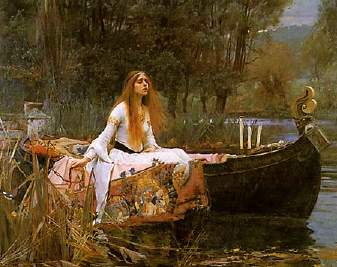With his queen, Guinevere, he maintained a magnificent court at Caerleon-upon-Usk (perhaps the legendary Camelot) on the southern border of Wales, where the Britons longest maintained their hold. His wars and victories extended to the continent of Europe, where he successfully defied the forces of the Roman Empire until he was called home because of the acts of his nephew Mordred, who had rebelled and seized his kingdom. In the final battle of Camlan, in southwestern England, the king and the traitor both fell, pierced by each other's spears. Arthur was mysteriously carried away to the mythical island of Avalon to be healed of his grievous wound. The first allusion to Arthur is in the Welsh poem Y Gododdin (circa 600). He is again mentioned in Historia Britonum (c. 850) of the Welsh historian Nennius (flourished about 800); the Annales Cambriae, in a 10th-century manuscript, mentions him, giving 537 as the date of his death; and the fully developed legend appears in the Historia Regum Britanniae (c. 1139) of the English chronicler Geoffrey of Monmouth.
The earliest references to Arthur are found in Welsh sources; the poem, Y Gododdin (circa 600), histories, written in Latin, in the 9th and 10th centuries, and tales in the Welsh story collection The Mabinogion (circa 1100). In one of these tales Arthur's wife, Guinevere, and his knights Kay, Bedivere, and Gawain make their appearance. The earliest continuous Arthurian narrative is in the Historia Regum Britanniae (circa 1139) by the English writer Geoffrey of Monmouth. Here Arthur is identified as the son of the British king Uther Pendragon, and his counselor Merlin is introduced. The Historia mentions the isle of Avalon, where Arthur went to recover from wounds after his last battle, and it tells of Guinevere's infidelity and the rebellion instigated by Arthur's nephew Mordred.
All later developments of the Arthurian legend are based on Geoffrey's work. Thus, the first English Arthurian story is in the poet Layamon's Roman de Brut (1205), an English version of Geoffrey's Historia. Arthur is depicted as a warrior on an epic scale; and the story of his magic sword Excalibur, which only he could extract from a rock, is included for the first time.
An Arthurian tradition also developed in Europe, probably based on stories handed down from the Celts who immigrated to Brittany in the 5th and 6th centuries. By 1100 Arthurian romances were known as far away as Italy. Inspired by chivalry and courtly love, they are more concerned with the exploits of Arthur's knights than with Arthur himself.
The oldest of the French Arthurian romances is a series of 12th-century poems by Chrétien de Troyes. One introduces Lancelot, Arthur's chief knight and his rival for Guinevere's love; another poem about Percival (see below) is the earliest story of the search for the Holy Grail, which from then on was incorporated into the legend. Chrétien's work had great influence on later Arthurian romance, particularly early German versions, such as Erec and Iwein, by the 12th-century poet Hartmann von Aue, and the epic Parzifal (c. 1210), by Wolfram von Eschenbach. By the early 13th century the story of Tristram and Iseult (or Tristan and Isolde), from another Celtic tradition, was added to the Arthurian legend.
English Arthurian romances, dating from the 13th and 14th centuries, concerned individual knights Percival and Galahad, the Grail knights, and especially Gawain. The culminating masterpiece of these was the anonymously written Sir Gawain and the Green Knight (c. 1370). A number of these Arthurian tales were retold, in English prose, by Sir Thomas Malory in his Morte d'Arthur (1485). On this book the poet Alfred, Lord Tennyson based his Idylls of the King (1859-85), an allegorical treatment of Victorian society.
Many other writers have adapted the stories of Arthur and his knights and their great court at Camelot to contemporary tastes and themes. The poet Edmund Spenser used Arthur, as the perfect knight, in his epic allegory of Elizabethan society, The Faerie Queene (1590-99). Mark Twain contrasted New England progressivism with medieval society in his A Connecticut Yankee at King Arthur's Court (1880). The Once and Future King (4 vol., 1939-58), by the English author T. H. White, remains a widely read modern version of the legend. Music, too, shows the abiding interest in Arthurian stories from the German composer Richard Wagner's Parsifal (1882) to the Broadway musical Camelot (1960), by Alan Jay Lerner and Frederick Loewe.
 wife of the semilegendary King Arthur of
Britain. She appears in the 12th-century Historia cycle of Arthurian
romances by the English chronicler Geoffrey of Monmouth as Gwanhumara,
a beautiful woman who became a nun after the defeat of King Arthur by
Mordred. In the 12th century romance Le chevalier ŕ la charette (The
Knight of the Cart), the French poet Chrétien de Troyes introduced the
story of the tragic love affair between Guinevere and Sir Lancelot du
Lac. The same story was treated by later English writers, notably by
Sir Thomas Malory in Le morte d'Arthur (1485) and by Alfred, Lord
Tennyson in Idylls of the King (1859-85).
wife of the semilegendary King Arthur of
Britain. She appears in the 12th-century Historia cycle of Arthurian
romances by the English chronicler Geoffrey of Monmouth as Gwanhumara,
a beautiful woman who became a nun after the defeat of King Arthur by
Mordred. In the 12th century romance Le chevalier ŕ la charette (The
Knight of the Cart), the French poet Chrétien de Troyes introduced the
story of the tragic love affair between Guinevere and Sir Lancelot du
Lac. The same story was treated by later English writers, notably by
Sir Thomas Malory in Le morte d'Arthur (1485) and by Alfred, Lord
Tennyson in Idylls of the King (1859-85).
Microsoft (R) Encarta.
Copyright (c) 1994 Microsoft Corporation.
Copyright (c) 1994 Funk & Wagnall's Corporation.